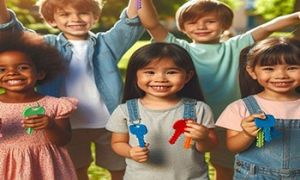Reflections are observing, listening, thinking deeply about the meaning of what you have observed and heard, and using that information to inform your practice and continually respond and reflect.
The following questions are to be used as a guide for reflecting on each of the standards within Quality Area 4. Use the information from these questions to recognize good practice or to change and improve what is not working well. It can also be used as part of Self-Assessment or Quality Improvement Plan.
Questions to guide reflection on practice for Standard 4.1
• How do our staffing arrangements support each child’s learning and development?
• How do our staffing arrangements support educators to direct their full attention to their work with children, including getting to know each child?
• How do our staffing arrangements support the consistent practice, including staff members’ and children’s transitions?
• How does our staffing roster support continuity of care and positive experiences for children on a day-to-day basis?
• How do we inform children and families when an educator is on leave and who will be working with them instead?
• How do we facilitate children’s and families’ familiarity with relief staff?
• How do we support relief staff to learn about and understand the service’s policies, processes?
• How do our staffing arrangements support educators to develop positive and respectful relationships with families?
• How do we provide feedback and support to educators so that they continue to learn and feel fulfilled, resulting in continuity of educators over time?
• How do we engage in reflective practice to support and encourage each other, support ongoing learning and focus on quality improvement?
• Do our service’s procedures support families to access alternative care when their usual educator is unavailable at short notice?
• What arrangements are in place to ensure that our principal office can support educators and families when children are in care overnight and at weekends?
• How do we communicate with educators and with families when there is a change of co-ordinator(s) at the service?
Questions to guide reflection on practice for Standard 4.2
• How do we ensure that the service’s statement of philosophy reflects the different views, beliefs and values of the team?
• How do we acknowledge the personal strengths, professional experiences and diversity that our colleagues bring to our work?
• What beliefs about relationships between management, educators, coordinators and other staff are reflected in our statement of philosophy?
• How do we promote professionalism, confidentiality and ethical conduct?
• What strategies have we developed to ensure information is appropriately shared between management and service staff?
• How do we use critical reflection to challenge our beliefs?
• How do we promote the personal and collective strengths of our team?
• How do we share the successes of our team with families?
• What opportunities do we provide for educators, co-ordinators and other staff to have conversations and discussions to further develop their skills, or to improve practice and relationships? How do we ensure that everyone’s voice is heard and considered?
• What makes our service a positive place to work?
• What strategies do we use to find out how staff members feel about/within our team?
• How effective are the processes we have implemented to resolve any ethical issues that may arise?
• How regularly do we review Early Childhood Australia’s Code of Ethics (2016) and our own service’s code of conduct and service philosophy to ensure that our practices and policies align with current recognised approaches?
For more information on how to write Reflections: Reflective Practices In Childcare
References:
New Guide To The NQational Quality framework, ACECQA, Oct 2017







 Here is the list of the EYLF Learning Outcomes that you can use as a guide or reference for your documentation and planning. The EYLF
Here is the list of the EYLF Learning Outcomes that you can use as a guide or reference for your documentation and planning. The EYLF The EYLF is a guide which consists of Principles, Practices and 5 main Learning Outcomes along with each of their sub outcomes, based on identity,
The EYLF is a guide which consists of Principles, Practices and 5 main Learning Outcomes along with each of their sub outcomes, based on identity, This is a guide on How to Write a Learning Story. It provides information on What Is A Learning Story, Writing A Learning Story, Sample
This is a guide on How to Write a Learning Story. It provides information on What Is A Learning Story, Writing A Learning Story, Sample One of the most important types of documentation methods that educators needs to be familiar with are “observations”. Observations are crucial for all early childhood
One of the most important types of documentation methods that educators needs to be familiar with are “observations”. Observations are crucial for all early childhood To support children achieve learning outcomes from the EYLF Framework, the following list gives educators examples of how to promote children's learning in each individual
To support children achieve learning outcomes from the EYLF Framework, the following list gives educators examples of how to promote children's learning in each individual Reflective practice is learning from everyday situations and issues and concerns that arise which form part of our daily routine while working in an early
Reflective practice is learning from everyday situations and issues and concerns that arise which form part of our daily routine while working in an early Within Australia, Programming and Planning is reflected and supported by the Early Years Learning Framework. Educators within early childhood settings, use the EYLF to guide
Within Australia, Programming and Planning is reflected and supported by the Early Years Learning Framework. Educators within early childhood settings, use the EYLF to guide When observing children, it's important that we use a range of different observation methods from running records, learning stories to photographs and work samples. Using
When observing children, it's important that we use a range of different observation methods from running records, learning stories to photographs and work samples. Using This is a guide for educators on what to observe under each sub learning outcome from the EYLF Framework, when a child is engaged in
This is a guide for educators on what to observe under each sub learning outcome from the EYLF Framework, when a child is engaged in The Early Years Learning Framework describes the curriculum as “all the interactions, experiences, activities, routines and events, planned and unplanned, that occur in an environment
The Early Years Learning Framework describes the curriculum as “all the interactions, experiences, activities, routines and events, planned and unplanned, that occur in an environment


